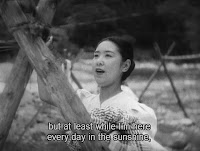I recalled those airplanes "following the sun" in a quite different context -- one that brought much greater meaning to the imagery of that phrase. I was watching a gentle 1941 Japanese movie, a soft-spoken romance titled Ornamental Hairpin (Kanzashi), directed by Hiroshi Shimizu. The emotional weight of the story surrounds the character Emi, who takes advantage of her having lost an ornamental hairpin to return to a country hospice to retrieve the piece of jewelry, and to apologize to the young man who was injured when he accidentally stepped on the hairpin in the deep water of the communal bath. Through Emi's conversations with a woman friend who follows her to the countryside to try to retrieve her, we learn that Emi is trying to find a way to separate herself from a relationship with a man back in Tokyo, a relationship she finds stifling, perhaps even repressive.
It is during one of those conversations that Emi speaks the line about following the sun. The friend had at first judged Emi as being irresponsible. But the friend's attitude changes as Emi conveys how her time vacationing in the countryside has given her new life. Emi describes how she has been spending her days outdoors, strolling and chatting with the young man and a pair of elementary-school boys, but also washing clothes in the river, hanging them in the sun to dry. Emi also points out how outdoors her skin has become less pale.
 |
| "but at least while I'm here every day in the sunshine" |
Reflecting now upon the film, I think about how Emi's words must have had additional meaning for a Japanese audience in 1941. Their nation had been at war with China for four years, and was now on the verge of being engulfed in the even larger World War II, which had already been expanding in Europe. It had to be a frightening and uncertain time for many Japanese people.
Hiroshi Shimizu's touching movie closes with two wordless scenes expressive of the presence of beauty in situations in which humans follow a hard or uncertain walk of faith: The beautifully appareled Emi, carrying a parasol, walking alone up a steep incline of steps. And Emi walking on a very narrow footbridge across the river.
~~~
Is there something that helps you face each day as it comes?
(The still photos are from the movie Ornamental Hairpin,
directed by Hiroshi Shimizu, © 1941 [based on a novel by Masuji Ibuse], and are used under Fair Use.)
directed by Hiroshi Shimizu, © 1941 [based on a novel by Masuji Ibuse], and are used under Fair Use.)

1 comment:
I like your idea of "following the sun" because it is something I might count on happening every day even if it is cloudy. I feel as if there are so few things we can count on as being predictable from day to day, so much seems to be changing so fast. Thank you for the idea. (I also liked your movie pictures.)
Post a Comment